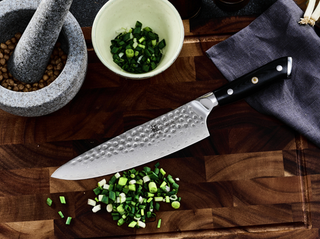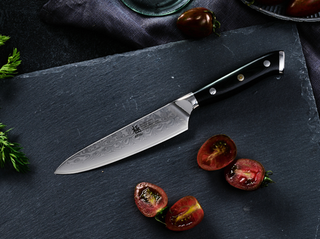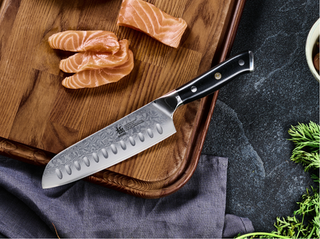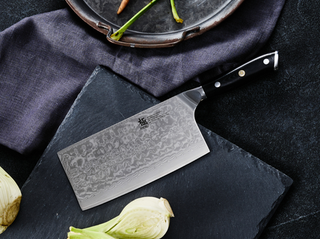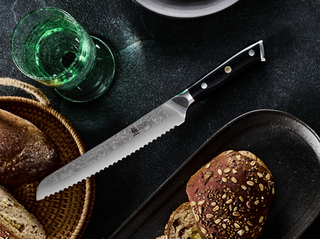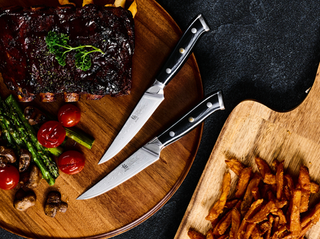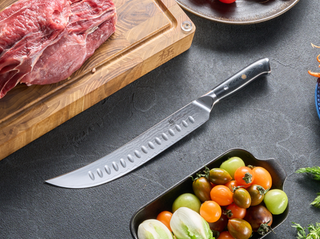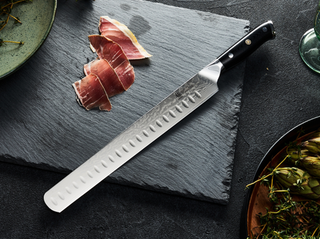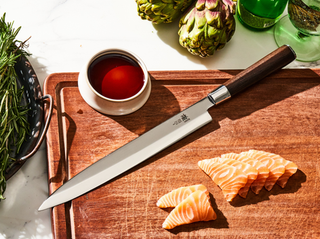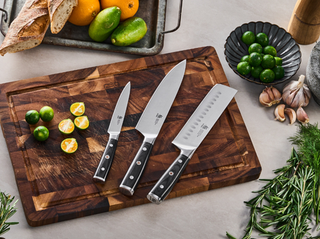The 5 Best Japanese Knives for Every Task of 2024 - A Complete Guide to Essential Japanese Cutlery
From centuries-old traditions to cutting-edge innovation, the art of Japanese knife-making blends mastery with state-of-the-art technology. We've explored the culinary world to bring you 5 of the best Japanese knives of 2024, each one a masterpiece carefully crafted for kitchen tasks both delicate and demanding. Join us as we uncover which Japanese knife is the ideal partner for every meal prep adventure.
Table of Content
- Introduction
- Types of Japanese Knives
- Introduce of the 5 Best Japanese Knives
- 10 Factors to Find Quality Japanese Knives
- Maintenance and Care for Janpanese Knives
- Fun Facts About Japanese Knives
- Conclusion
Types of Japanese Knives
With centuries of rich tradition behind each meticulously crafted blade, Japanese knives represent the pinnacle of culinary cutlery. Just the sight of these exemplars of artisanal knifemaking instills awe and inspiration. Let's delve into the majestic world of the top Japanese knife types, where beauty and unrivaled performance go hand in hand.
Japanese cuisine is renowned for its precision and attention to detail, and Japanese knives play a significant role in achieving culinary excellence. Here are some of the most common types of Japanese knives:
1. Chef Knife/Gyuto Knife:The Gyuto knife is widely recognized as the Japanese version of the Western chef’s knife, tailored for versatility and efficiency in various culinary tasks. Its design boasts a gently curved blade that enhances the rocking motion ideal for chopping herbs and vegetables, while the pointed tip excels at fine slicing and precision cuts. The Gyuto knife is adept at handling large cuts of meat, dicing robust vegetables, and mincing delicate herbs, making it a fundamental tool in any culinary setting.
2. Santoku Knife:The Santoku knife, whose name translates to "three uses," is adept at slicing, dicing, and mincing, making it a kitchen staple. This knife features a shorter, wider blade that offers excellent maneuverability and weight balance, crucial for quick chopping actions. The flat cutting edge ensures full contact with the cutting board, allowing for clean slices, while the granton edge helps to release thin slices and sticky food after slicing. This makes the Santoku knife particularly useful for handling fish, meats, and cheeses.
3. Nakiri Knife: The Nakiri knife is designed specifically for vegetables, offering a straight blade that cuts straight down without the need for pulling or pushing, ideal for precise, straight slices. Its squared-off tip helps in finely dicing and chopping dense vegetables, and the double-edge blade is suitable for both right and left-handed users. With its balanced weight and handle design, the Nakiri knife provides a comfortable grip and effective cutting capability, making it essential for vegetarian dishes and intricate garnishes
4. Yanagiba Knife:The Yanagiba knife is a traditional Japanese slicing knife that features a long, thin blade, making it perfect for cutting sashimi and sushi. Its single-edged design allows for thin, precise cuts, reducing cellular disruption to the fish’s flesh and preserving its original texture and flavor. The blade's length also enables the chef to slice through an ingredient in one smooth movement, essential for maintaining the integrity of delicate ingredients like raw fish.
5. Usuba Knife: The Usuba knife is specialized for precision work with vegetables, featuring a thin, straight blade that provides minimal resistance as it slices through even the softest vegetables. Its sharp, single-bevel edge is perfect for making clean cuts, and is especially valued for tasks requiring precision, such as creating thin vegetable sheets or intricate decorative cuts. The knife's design focuses on delivering precise control and ease of handling through its balanced structure.
6. Honesuki Knife:The Honesuki knife is a Japanese boning knife, characterized by its angular blade and robust construction, making it ideal for deboning and trimming poultry and other meats. Unlike typical Western boning knives, the Honesuki's triangular profile provides excellent precision for getting between meat and bone, and its sturdy handle ensures a firm grip during intricate tasks. Its specialized shape allows chefs to make precise cuts with ease, enhancing the preparation of meat with minimal waste.
7. Kiritsuke Knife:The Kiritsuke knife is a versatile Japanese knife that combines elements of both a slicer and a vegetable knife. This dual-purpose knife is characterized by its angled tip, which provides the agility needed for detailed tasks, and a flat edge that excels in chopping and slicing duties. The length and weight of the Kiritsuke knife make it a favored tool for chefs who appreciate its ability to handle a range of tasks from precise vegetable work to slicing large pieces of meat.
8. Deba Knife: The Deba knife is traditionally used in Japanese cooking for filleting fish and cutting through small bones and cartilage, making it indispensable in the preparation of seafood. Its heavy, thick blade allows the chef to exert control and apply force effectively, especially near the knife's heel, while the fine, sharp edge ensures precise cuts. The Deba knife is also adept at other tasks such as poultry butchering, where its robust construction helps in making clean cuts through joints and tendons.
The Deba knife is essential for precise cuts when working with fish. It is useful for both sushi chefs and home cooks.
Each knife has its specific purpose and is crafted to provide unmatched sharpness, edge retention and performance - the hallmarks of Japanese cutlery.
“Japanese knives are known for their thinness, hardness, and sharpness. The best ones provide "scalpel-like precision" unmatched by Western knives.”
- Chad Ward
Introduce of the 5 Best Japanese Knives
Japanese Chef Knives
Crafted to perfection, this Japanese chef's knife features an 8-inch blade made from Damascus steel, making it highly wear-resistant and less prone to rusting for extended use. However, what truly sets Japanese knives apart is their unrivaled craftsmanship and attention to detail, passed down through generations of skilled artisans.
As a result, the blade achieves impeccable sharpness, excellent edge retention, and effortless slicing ability. When using Japanese chef's knives, their sharp precision makes cutting meat and hard vegetables like squash easy and fast.
Meanwhile, the thin and lightweight blades excel at slicing fruits and vegetables, whether julienne, dicing, or thin slicing for complex techniques. From dicing lettuce to carving fruit decorations, Japanese knives handle a variety of kitchen tasks with ease as one of a chef's most versatile tools.
Japanese Cleaver Knife
This sturdy Japanese Cleaver Knife is designed to conquer even the toughest ingredients with its hefty 7-inch rectangular blade. Showcasing exceptional cutting power and remarkable durability, its weighty construction allows for effortless chopping, smashing, and tenderizing. This makes it an indispensable tool for any kitchen.
The real advantage of the Cleaver Knife is its versatility. It can seamlessly tackle a wide range of tasks, from breaking down large cuts of meat to mincing garlic or crushing spices. With a single swing, this knife transforms ingredients into uniform pieces, reducing prep time while ensuring consistent results. Unleash your creativity as you explore the possibilities with this culinary workhorse.
Whether an experienced chef or an enthusiastic home cook, the Cleaver Knife is a must-have addition to any culinary arsenal. Its robust build and versatility make it perfect for diverse tasks, from butchering to mincing and beyond. Embrace the power and finesse of the Cleaver Knife to bring your cooking to the next level.
Jpanese Slicing Knife
Here is a modified version of the sentence to sound more natural:
The Japanese Slicing Knife, also known as a Sujihiki or Yanagiba, is an essential specialized knife designed specifically for graceful slicing. This 12-inch blade is a crucial tool in Japanese cuisine, ideal for delicately handling fish, meats, and fruits.
The primary purpose of the Japanese Slicing Knife is to create uniform, paper-thin slices with unparalleled precision. Its elongated, slender shape allows for smooth, uninterrupted strokes that reduce friction and ensure clean cuts, preserving ingredients' integrity. The single-beveled blade enhances control and facilitates wafer-thin slices.
This knife is commonly used for various culinary techniques including sashimi, filleting fish, carving roasts, and more. The Japanese Slicing Knife enables chefs to elegantly slice sashimi and transform ingredients into culinary works of art. Embrace finesse with this specialized blade that empowers perfection.
Japanese Bread Knife
The Japanese Bread Knife, known as the "pan slicer" or "gyuto bread knife," is a versatile specialized blade designed for effortless slicing of breads and baked goods. This knife excels at cutting through crusty loaves, soft pastries, and delicate cakes with unparalleled precision and ease.
The Japanese Bread Knife's purpose is to create flawless, even slices without tearing or squashing delicate baked goods. Its innovative design and signature serrated edge make it highly effective for:
1.Slicing bread loaves with clean lines
2.Cutting soft pastries and cakes into perfect portions
3.Chopping fruits and vegetables with accuracy and more.
Combining the acute cutting ability of Japanese knives with the saw-like edge of Western serrated blades, the Japanese Bread Knife features high-quality stainless steel that maintains its sharpness slice after slice.
Embrace this specialized knife to elevate your baking and unlock beautiful presentations.
Janpanese Utility Knife
The Japanese utility knife, also known as a petty knife, is a versatile and multi-purpose blade that finds use in various culinary applications. Typically ranging from 4 to 7 inches (10 to 18 cm) in length, this smaller knife boasts exceptional control, precision, and agility, making it popular among both professional chefs and home cooks.
The primary purpose of the Japanese Utility Knife is to handle tasks requiring intricate, delicate cuts and fine knife work, including precision cutting, paring, trimming, boning, and small ingredient prep.
While not as specialized as some Japanese knives, the utility knife's versatility and precision make it an indispensable addition to any kitchen. Its finesse and ability to adeptly tackle a wide range of jobs, from everyday to delicate, explain its popularity as an essential cooking tool.
10 Factors to Find Quality Japanese Knives
Japanese Knives Blade Material
The blade material you choose is very important because it has a direct effect on how well the knife works. People value Aogami (Blue Steel) because it can keep its sharp edge after a lot of use. This makes it perfect for skilled chefs who need both durability and great sharpness. White steel, on the other hand, is lighter and easier to sharpen, so it is used when the sharpest edge needs to be made quickly. The best things about VG-10 steel are that it doesn't rust and can keep an incredibly sharp edge. It can be used in both business and personal settings. Newer materials, such as SG2/R2 steel, have a great mix of hardness, sharpness, and durability. High-end knives like these are made with them because they last a long time.
Construction and Craftsmanship
What kind of building method is used affects both how long the knife lasts and how nice it looks. Traditional Japanese knives may be made using a "Honyaki" forging method in which the whole knife is forged from a single piece of high-carbon steel. This gives the knife unmatched sharpness and a unique hamon (temper line) that makes it look beautiful. Instead, "Kasumi" knives, which are made from a mix of soft iron and high-carbon steel, work just as well but are less expensive. The care with which these knives are finished by hand, with skilled artisans polishing and sharpening them adds to their quality and makes them even more special.
Blade Design and Geometry
Each blade form is best for a certain job. The curved edge of a gyuto knife makes it easy to chop veggies by rocking the knife back and forth. Nakiri knives, on the other hand, have a straight blade that is best for making the exact up-and-down movements needed for chopping vegetables. Yanagiba knives are more useful because they have a long, thin shape that makes them perfect for the exact filleting needed to make sushi. The slope and tapering of the blade also affect how well the knife cuts and how easy it is to clean. For example, a blade with a more steep angle is sharper, but it may need to be cared for more often to keep its edge.
Handle Design and Ergonomics
Japanese traditional knife handles are usually made from natural woods like magnolia or ho wood. They are designed to be easy to hold on to and stay in place, which is important for precise cutting. Contemporary materials like Micarta and G-10 add a modern touch and offer better longevity, resistance to water, and a non-slip surface. You should also think about the shape of the handle. For example, an octagonal handle gives you a good grip and keeps the knife from twisting in your hand, which is important for jobs that need precision and control.
Balance and Weight
The balance of a knife shows how easy it is to use. For professional chefs who use knives a lot, a knife that is properly balanced makes them more efficient and reduces wrist strain. The right knife weight depends on what it will be used for. For example, heavier knives like the Deba are better for cutting through tough materials like fish bones, while lighter knives like the Santoku are better for jobs that need to be done quickly and accurately. Balance is very important because the way the weight is distributed from the blade to the handle affects how well the knife works for different cooking jobs.
Sharpness and Edge Retention
One thing that makes Japanese knives unique is that they are very sharp and can keep their edge for a long time. This is mostly because the steel used, like Aogami and Shirogami, has a lot of carbon in it, which makes the edge thinner and sharper. Besides making the steel harder and better at keeping its edge, the heat treatment and quenching steps also make the knife significantly sharper. When picking out a knife, you should think about how long the edge will last and how often it will need to be sharpened.
Maintenance and Care
Japanese knives need to be serviced regularly to keep their quality and usefulness. In addition to regular grinding, this includes the right way to clean, dry, and store the tool. Some blade materials, like high-carbon steels, can rust if they are not taken care of properly, so they might need more care than stainless steel blades. Knowing how to take care of a knife will help you pick one that you can effectively take care of based on your habits and the place where you live.
Aesthetic Value
The way a knife looks can be important, especially in a business setting where the way tools are displayed adds to the chef's image. A lot of Japanese knives are not only useful, but also very well made. The blades often have elaborate designs like Damascus patterns or a unique Tsuchime (hammered) finish. These little features can make the knife look better and be useful too, like keeping food from sticking to the blade.
Cost and Value for Money
The price of a Japanese knife can vary a lot based on the materials used, the way they are made, and how well they are crafted. It's important to weigh the price of the knife against how well it will work and how long it will last. While more expensive knives usually have better quality and last longer, there are also great mid-range options that are a good deal, especially for home cooks or people who are new to Japanese knives.
Customization and Personal Preferences
Last but not least, think about how much a knife can be changed to fit your needs. Some makers let you pick from different handle materials, blade lengths, or even ask for specific changes to be made to the shape of the blade. By making changes to your knife, you can make sure that it not only works well for you but also feels good in your hand, which will make cooking more enjoyable.
Maintenance and Care for Japanese Knives
1. Cleaning and Drying:
After using a Japanese knife, it should be cleaned by hand right away. Do not use dishwashers because the strong chemicals and high temperatures can hurt the blade and the things that you put in them. To clean the knife gently, use light dish soap and a soft sponge. Make sure to get rid of any acidic food residues that could damage the blade. To keep the knife from rusting, dry it completely with a soft towel after washing it. This is especially important for high-carbon steel knives, which are more likely to rust.
2. Regular Sharpening:
It's important to keep your knife sharp for safety and performance reasons. A whetstone is the best tool for sharpening because it lets you control the angle and edge very precisely. Several types of stones are usually used in the process. A coarse grit is used to reshape dull edges, then a medium grit, and finally a fine grit is used to polish the edge. If you're not sure how to sharpen a blade properly, you should learn how to do it or get help from a professional. If you don't, you could damage the blade.
3.Oil Application:
For high-carbon steel knives, a small coat of food-safe oil, like camellia oil, can keep the blade from rusting and turning black. This is especially important if you live in a wet area or plan to keep the knife for a long time. Cover the whole metal surface of the blade with a soft cloth and lightly rub the oil on it.
4. How to Store It:
Keep your Japanese knives somewhere dry and safe. The best ways to store knives are in knife blocks, magnetic strips, or individual sheaths, also known as sayas. These ways of storing the blades keep them from touching other tools that could damage the edges. Knives shouldn't be kept in drawers, where they could get hit and broken.
5.Stay away from bones and frozen foods:
Japanese knives are made for precise cutting, not heavy-duty jobs like chopping bones or frozen foods. If you use your knife on the wrong things, the blade could get chips or cracks. A Western-style knife or a cleaver is a better choice for these harder jobs.
6. Techniques for Handling and Use:
Use the right cutting methods to make your knife last as long as possible. Instead of chopping hard, slice gently. Also, only cut on wood or bamboo cutting boards. Glass or metal can quickly dull the blade if you cut on them.
Fun Facts About Japanese Knives

Damascus Pattern: Many Japanese knives feature a beautiful Damascus pattern on the blade. This pattern is created by layering and folding different types of steel, resulting in a visually stunning and highly durable blade.

Japanese knives are often made from high-carbon steel, such as aogami and shirogami. Skilled craftsmen spend years honing their skills to create blades that are not only sharp but also balanced, ergonomic, and aesthetically pleasing.

Japanese knives hold a special place in Japanese culture. They are considered essential tools for preparing traditional Japanese dishes, and their craftsmanship is deeply respected. Knife enthusiasts all over the world can place a high value on rare and limited-edition knives.
People Also Read about Kitchen Kives
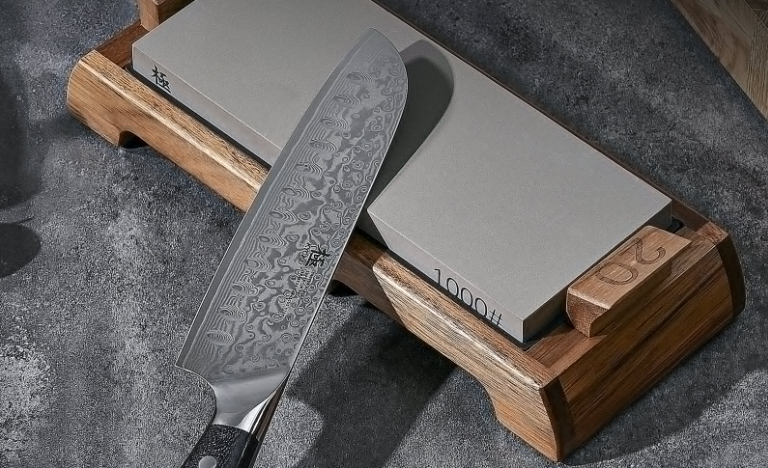
How to Clean a Damascus Steel Knife the Right Way
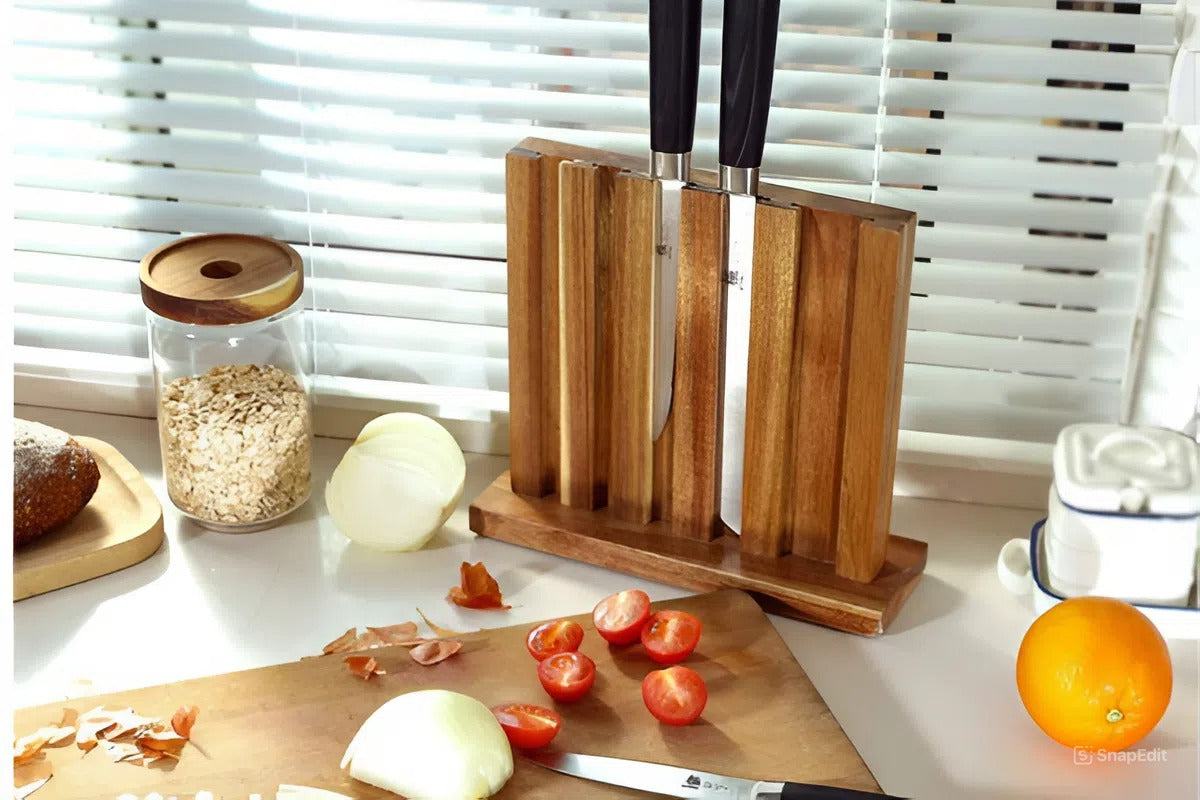
Top 5 Places to Put a Knife Block in the Kitchen
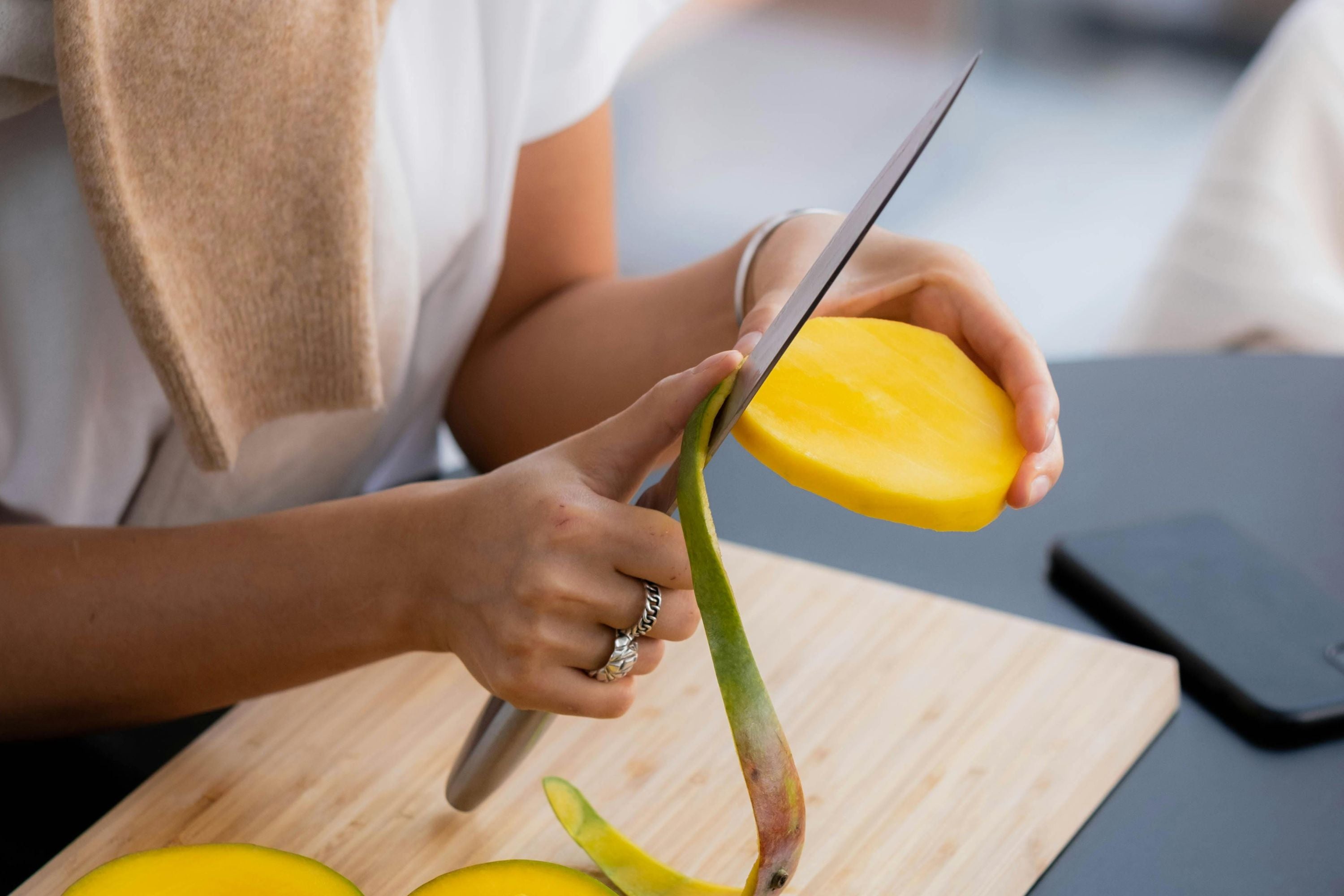
How to Slice a Mango
Have Any Questions?
We are here to answer all of your queries
